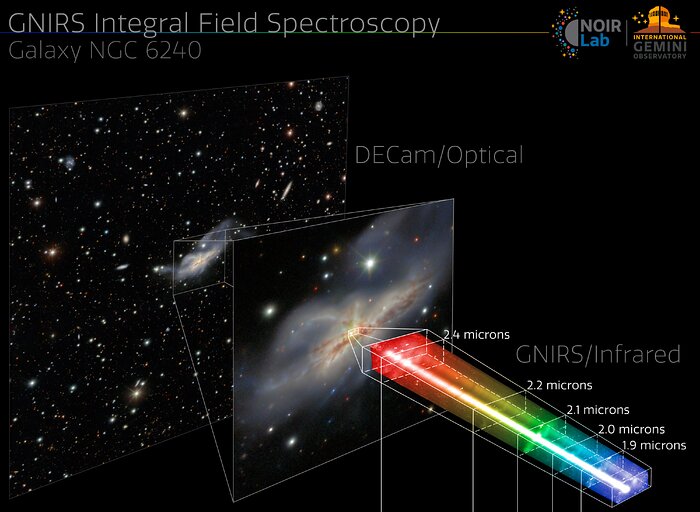Gemini North’s New 3D Vision
Over the past two decades, the Gemini Near-Infrared Spectrograph (GNIRS) on the Gemini North telescope has peered into faraway quasars, ancient galaxies, and puzzling brown dwarfs. Now, this incredibly productive instrument of the International Gemini Observatory, operated by NSF NOIRLab, is equipped with an integral field spectrograph.
This upgrade effectively gives Gemini North ‘3D vision'. As illustrated in this infographic, GNIRS can now take a 2D field of view and extract a spectrum out of every pixel in near infrared. Standard spectroscopy would create this spectrum for only the entire field of view.
This week’s Image of the Week shows the new spectroscopic capacity of GNIRS using NGC 6240 (nicknamed the Starfish Galaxy). The galaxy is a messy merger between two, maybe even three, smaller galaxies. At the center of the NGC 6240 are two distinct cores, seen in the infographic as two columns inside the spectrum. Studies have shown that these cores are — at least — two supermassive black holes from the original centers of the merging galaxies. By examining the spectrum of each individual pixel, astronomers can better explore the complexity of this galaxy and other celestial objects with one of the largest optical telescopes on Earth.
You can examine NGC 6240 yourself with this detailed image taken by the Dark Energy Camera (DECam). DECam was made by the U.S. Department of Energy (DOE) and is mounted on the Víctor M. Blanco 4-meter Telescope at Cerro Tololo Inter-American Observatory in Chile, another Program of NOIRLab.
Credit:International Gemini Observatory/NOIRLab/NSF/AURA/GNIRS Team
Image processing: M. Rodriguez (Gemini Observatory/NSF NOIRLab), J. Miller (Gemini Observatory/NSF NOIRLab), & M. Zamani (NSF NOIRLab)
About the Image
| Id: | iotw2342a |
| Type: | Artwork |
| Release date: | Oct. 18, 2023, noon |
| Size: | 5068 x 3704 px |
